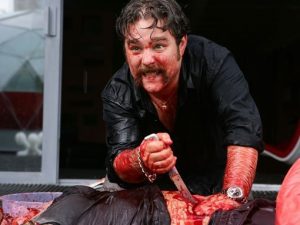Death in Dead Set breaks some of the fundamental rules of film. Actually, the entire series as a whole breaks some – if not all – of the rules in the 5 phases of disaster located in Susan Sontag’s “Against Interpretation.” Although this is fits into the horror genre, it contains certain sci-fi elements.
These include (Sontag 209-210):
- The arrival of the thing
- Confirmation of the hero’s report by a host of witnesses to a great act of destruction
- Conferences between scientists and the military take place, with the hero lecturing
- Further atrocities, the hero’s girlfriend is put in grave danger
- More conferences, whose motif is: “They must be vulnerable to something.”
Most importantly, “The films reflect world-wide anxieties, and they serve to allay them,” (225).
So why did Dead Set go with the ending it had? Why was there no explanation behind the disease? Why didn’t we get a close up of any scientists working in the background? Why was the ending so abysmal? All of these could be answered by the fact that this show is a giant metaphor, but still… the unexpected bleakness of the ending was totally shocking and somewhat unsatisfying.
Here’s a few things that riled me up, because I wasn’t expecting them:
NO ONE SURVIVES – not even the main heroine!
 www.mediafactory.org.au/michael-liberale/2015/08/13/dead-set-and-zombie-audiences/%5B/caption%5D
www.mediafactory.org.au/michael-liberale/2015/08/13/dead-set-and-zombie-audiences/%5B/caption%5D
“The rule, of course, is that his horrible and irremediable form of [disaster] can strike anyone in the film except the hero,” (222). Whelp. That’s thrown out of the window!
Those who commit heinous acts or sexually transgress make it to the FINAL episode, while the innocent die almost immediately (minus Riq).
In horror movies, who dies first? THE ONES WHO DO BAD THINGS! Even the ones who sexually transgress – i.e. commit adultery, lose virginity, etc – are typically thrown out of the window. Didn’t anybody watch Scream?
 www.tes.com/lessons/Mt2fWMCEz9-7oA/scream%5B/caption%5D
www.tes.com/lessons/Mt2fWMCEz9-7oA/scream%5B/caption%5D
Nevertheless, who dies before the scum of the show? Alex and Riq, the two most innocent characters.
The ONLY two likeable characters in the entire show are Alex and Riq. Alex dies somewhere halfway, while Riq is shot by Patrick in the end. Matt points out that Riq is the only character that is not eaten or killed by a zombie. Even when all hell breaks loose and the gates open, the zombies jump over Riq to get to the other people. He was the only one who didn’t watch the show. He was the only uncorrupted protagonist.
On the other hand, who gets to live?
- The guy in the pink shirt who opened the door and got one of the members killed in the first place
- The piece of crap, Patrick, who stays on until the end. Admittedly, this made his death even more satisfying (though I couldn’t watch it!). Never has there been a character that I hated more than him.
- Gollum, the perverted old fool, lives long enough to kill everybody by opening the gate. Was this an act of revenge on the group for making fun of him? He was corrupted since the beginning, but he made it to the final episode. Yay.
- Kelly is a dear, but didn’t she cheat on her boyfriend? According to Jeffrey Cohen’s “Monster Culture (Seven Theses)”, those who commit sexual transgressions are doomed to die or become an outcast. Kelly turns this on it’s head, because not only does she survive the longest – she is one of the leaders in the group.
Something that was less surprising was this…
The bodies of the ONLY two minority characters are mutilated, plus they are the first two who die in the main group. Not sure if this is worth pointing out, but it did come to mind almost immediately. Another metaphor?
 dawningcreates.com/tag/dead-set/%5B/caption%5D
dawningcreates.com/tag/dead-set/%5B/caption%5D
Works Cited
Brooker, Charlie. Dead Set. E4. directed by Yann Demange. Netflix.
Cohen, Jeffrey Jerome. Monster Culture (Seven Theses). 4-25.
Sontag, Susan. Against Interpretation and Other Essays. New York: Delta-Dell, 1966. 209-225.
